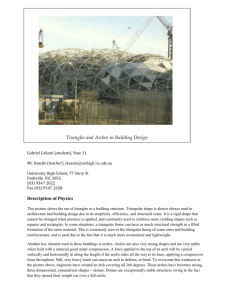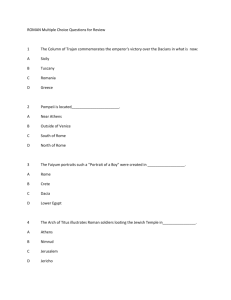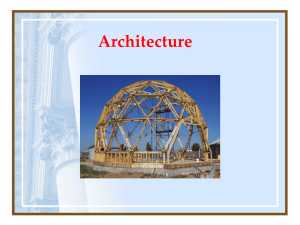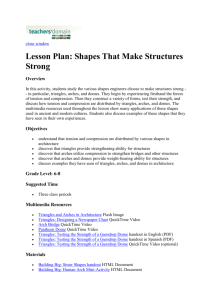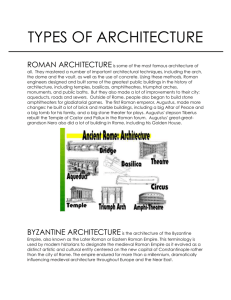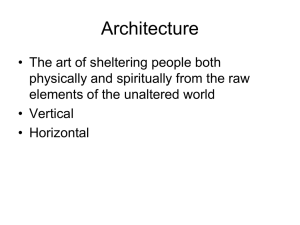Arches - WordPress.com
advertisement
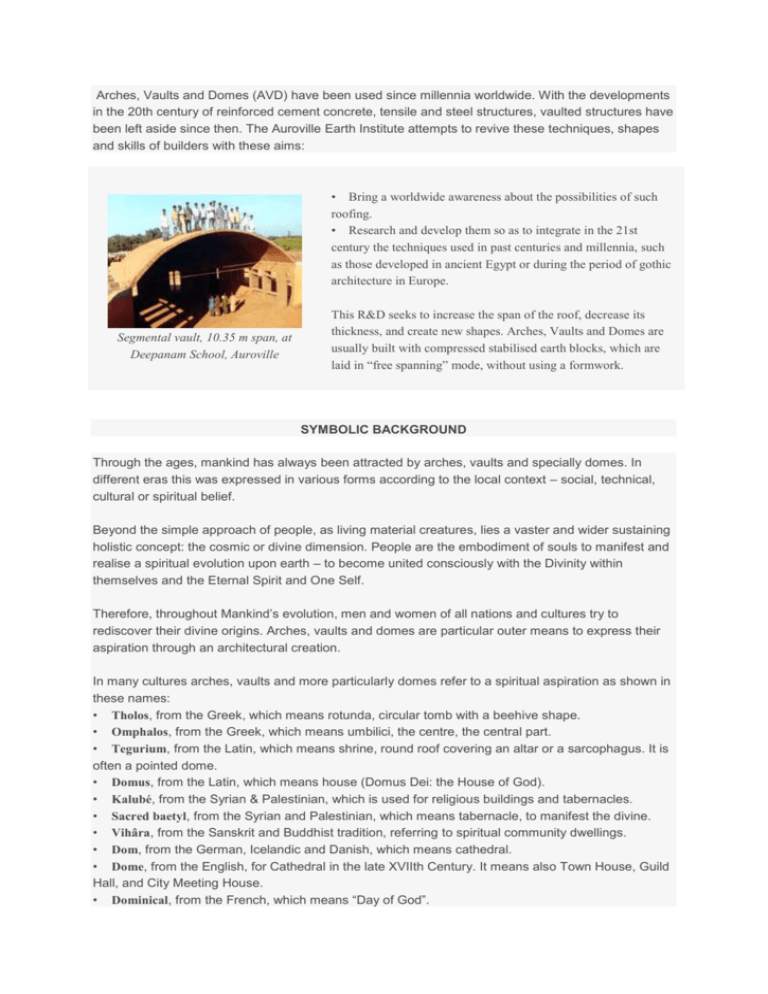
Arches, Vaults and Domes (AVD) have been used since millennia worldwide. With the developments in the 20th century of reinforced cement concrete, tensile and steel structures, vaulted structures have been left aside since then. The Auroville Earth Institute attempts to revive these techniques, shapes and skills of builders with these aims: • Bring a worldwide awareness about the possibilities of such roofing. • Research and develop them so as to integrate in the 21st century the techniques used in past centuries and millennia, such as those developed in ancient Egypt or during the period of gothic architecture in Europe. Segmental vault, 10.35 m span, at Deepanam School, Auroville This R&D seeks to increase the span of the roof, decrease its thickness, and create new shapes. Arches, Vaults and Domes are usually built with compressed stabilised earth blocks, which are laid in “free spanning” mode, without using a formwork. SYMBOLIC BACKGROUND Through the ages, mankind has always been attracted by arches, vaults and specially domes. In different eras this was expressed in various forms according to the local context – social, technical, cultural or spiritual belief. Beyond the simple approach of people, as living material creatures, lies a vaster and wider sustaining holistic concept: the cosmic or divine dimension. People are the embodiment of souls to manifest and realise a spiritual evolution upon earth – to become united consciously with the Divinity within themselves and the Eternal Spirit and One Self. Therefore, throughout Mankind’s evolution, men and women of all nations and cultures try to rediscover their divine origins. Arches, vaults and domes are particular outer means to express their aspiration through an architectural creation. In many cultures arches, vaults and more particularly domes refer to a spiritual aspiration as shown in these names: • Tholos, from the Greek, which means rotunda, circular tomb with a beehive shape. • Omphalos, from the Greek, which means umbilici, the centre, the central part. • Tegurium, from the Latin, which means shrine, round roof covering an altar or a sarcophagus. It is often a pointed dome. • Domus, from the Latin, which means house (Domus Dei: the House of God). • Kalubé, from the Syrian & Palestinian, which is used for religious buildings and tabernacles. • Sacred baetyl, from the Syrian and Palestinian, which means tabernacle, to manifest the divine. • Vihâra, from the Sanskrit and Buddhist tradition, referring to spiritual community dwellings. • Dom, from the German, Icelandic and Danish, which means cathedral. • Dome, from the English, for Cathedral in the late XVIIth Century. It means also Town House, Guild Hall, and City Meeting House. • Dominical, from the French, which means “Day of God”. In other cultures, domes refer also to: • The Cosmic Egg: In Egypt, India, Persia and Greece, they are seen as the egg at the origin of the Creation. • The Celestial Helmet: This is related to the Cosmic Egg in the Palestinian, Christian and Hebraic tradition. It is seen as the priest of heaven, symbol of authority and Divine Power. • The lotus: In the Egyptian and Indian spiritual traditions, it is seen as a manifestation of the divine. TECHNICAL BACKGROUND Steps in the architectural evolution When mankind was still in a nomadic state, people’s links with the cosmos through the starlit sky was obvious and crucial. Thus, dwellings were circular and covered either with cones or domes made of branches. These huts were referred to the centre, the number 1, the circle. These structures can still be found where there are nomadic cultures, like in Somalia. African bulbous, made of branches and covered with skin or canvas Qubâb, round hut Syria, Somalia, before being plastered Qubâb, round hut Syria, Somalia, with thatch roof When people slowly settled down, the circle evolved to the square, the number 4, which is related to the Mother Earth. Some houses were still covered by domes, often hemispherical, which are still found a lot in Muslim architecture and in Egypt. Later on, quadrangular plans and pyramidal or flat roofs prevailed. Steps in the technical evolution Originally made of branches, the conical or spherical nomad huts evolved into an organized and studied carpentry, more durable and stronger. It allowed building wider spans and higher rise. Wooden domes were for a time predominant in major architecture due their lightness, flexibility and earthquake resistance. But wooden domes were lacking the sense of eternity searched for by mankind, especially for spiritual or religious buildings. Thus the stone and brick masonry emerged progressively through the ages. More durable than wooden domes, they were lacking lightness and stability, and also required heavy load bearing walls because of their weight and thrust. They were also more sensitive to earthquakes. Over the ages, people developed first many types of arches and later on many kinds of vaults and domes. Arches were mainly used to easily span openings without using wooden beams. This was done according to their cultural and technical developments and the available materials. Vaults and domes were not only developed for technical reasons or to avoid the use of wood. As we have seen, they manifested also a spiritual dimension, as happened with the development of Gothic architecture in Europe. In this period of time, there was such a religious fervour, that architects and builders could find the way to transform the heavy and massive Roman style into structures of lightness with the Flamboyant Gothic architecture. Barrel and groined vaults evolved into the rib system of the pointed vaults. These developments were often the result of technical experiments which were not always immediately successful. Conical shape Pointed shape Hemispherical shape Early branch development of domes Hemispherical shape with joint curved pieces Hemispherical shape with truss beams Cloister dome shape with truss beams Wooden development of domes Hemispherical shape Pointed shape Catenary shape Masonry development of domes PAST AND PRESENT DIVERSITY OF VAULTED STRUCTURES An almost infinite variety of arch types, styles and shapes can be found all over the world. This variety evolved with the available local materials, and know-how of the time, but especially with the particular creativity and preferences of a culture. Arches Semicircular arch – France Bucket arch – Brazil Segmental arch – Auroville Corbelled arch – Auroville Corbelled arch – Greece, 1325 BC Segmental arch – Ivory Coast Rampant arch – Auroville Pointed segmental arch – Somalia Pointed arch – Gujarat, India Pointed “slab” arch – India Pointed arch – Turkey Pointed “slab” arch – India Bucket pointed arch – Turkey Bucket pointed arch – Rajasthan Bucket pointed arch – Agra, India Vaults and domes Vaults and domes also show a wide variety of shapes, but less than the arches. The oldest vaults still standing were built around 1300 BC in Egypt: the vaults of the Ramasseum in the “rest” of Thebes which were the granaries of the pharaoh. Ramasseum – Gourna, Egypt, ~ 1300 BC Nubian vaults ± 4 m span, built with adobes Tomb of Atreus – Mycenae, Greece, 1325 BC Pointed dome ~ ø 18 m built with stones Iwan of the Palace of Ctesiphon – Iraq, 6th century Vault 21 m span, 30 m high, built with fired bricks Basilica Haghia Sophia - Istanbul, Turkey, 6th century Hemispherical dome on pendentives 34 x 35 m School – Auroville, 1995 Segmental vault 10.35 m span built with CSEB Dhyanalingam Temple – Poondi, India, 1998 Segmental elliptical ø 22.16 m, built with fired bricks Training centre, built with CSEB – Auroville, 1995 – Catenary vaults of various shapes and spans School, built with CSEB – Auroville, 1995 – Cloister dome 5.70 m square, 2.15 m rise TERMINOLOGY AND TYPOLOGY Arches always generate the section of vaulted structures. • Vaults are generated by the projection of the arch section on a plan, which is most of the time horizontal. • Domes are basically shaped by the rotation of the arch section around a vertical axis. They can be built on circular or quadrangular plans. The main exceptions to this principle are: • Domes on squinches are made by a succession of increasing arches starting from the corners. The squinche looks like a half cone or portion of a cone, if the generating arch is not pointed. • Faceted domes are generated by the intersection of vaults, like the cloister dome. But it is built on a faceted plan and not a square or quadrangular plan like the cloister dome. • Groined vaults or domes are the intersection of two vaults crossing each other. Most of the time, they cross perpendicularly. • Cloister domes are also generated by the intersection of two vaults crossing each other, like the groined vault. The groin of the groined vault is identical to the inner edge of the cloister dome. The arch section of the cloister dome is not seen on the side of the dome, but only the cross sections. Terminology for an arch Terminology for a centring Note that both supports of a centring should be done with the same material: the example showed above is to show two different cases. The examples of AVD shown hereafter are only the basic types which are commonly found. The variety of AVD is much greater than that. Note that the name of the arch is defined by its intrados shape. Basic typology of arches and vaults Basic typology of domes
